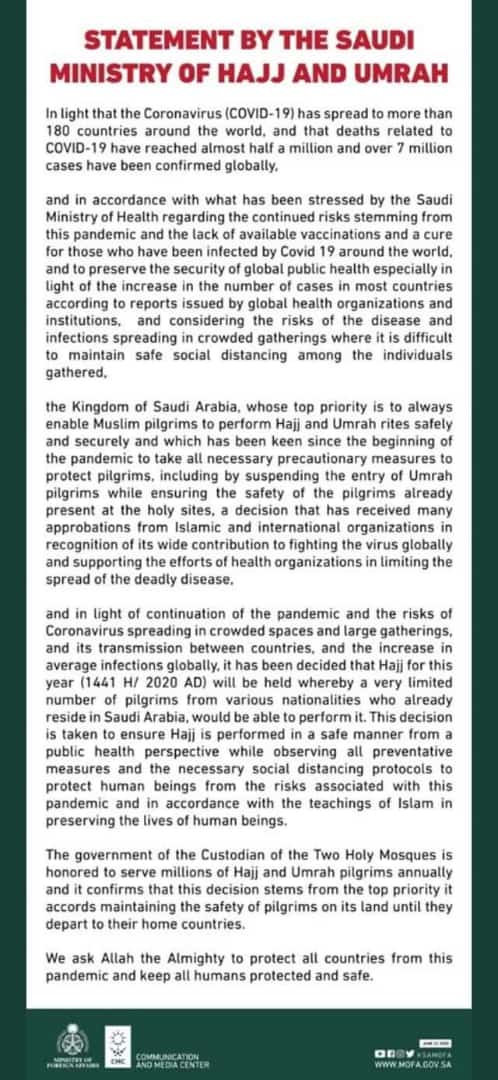The Kingdom of Saudi Arabia has announced that Hajj 2020 2020 will be a ‘very limited’ Hajj due to the Coronavirus outbreak.
The Kingdom has allowed her citizens to partake in the pilgrimage that has started since last July.

“It was decided to hold the pilgrimage this year with very limited numbers … with different nationalities in the kingdom,” the official Saudi Press Agency said on Monday, citing the Hajj ministry.
With more than 161,000 total confirmed cases and 1,307 deaths, the Kingdom has on of the highest cases of the Coronavirus in the middle east.
Since late February, the kingdom has suspended the Umrah pilgrimage to Mecca due to the outbreak.
The Hajj pilgrimage has been stopped about 40 times in history for different reasons.
865 CE massacre at the level of Arafa:
- Corresponding to 251 AH, the heroes of the Hajj, after witnessing the massacre at the level of Arafat, where Ismail bin Youssef Al-Alawi and those with him attacked the crowds of the pilgrims, and they killed large numbers
930 CE Carmatians and theft of black stone
- Corresponding to 317 AH, Carmatians raided a heinous crime on the Sacred Mosque and killed those in it and stole the Black Stone and were absent for 22 years and did not return to its place except in 339 AH, where Carmatians believed that the pilgrimage is one of the rituals of pre-Islamic and idolatry.
983 AD disputes between Bani Abbas and Bani Ubaid
- Corresponding to 372 AH, it was said that no one from Iraq this year went to the year 380 AH because of the discord and differences between the successors of Bani Abbas and the successors of Egypt Bani Ubaid.
1037 m pilgrims from Egypt only
- Corresponding to 428 AH, no pilgrims from Iraq and pilgrims from Egypt and others.
1253AD Baghdadis return after 10 years
- Corresponding to 650 AH, the people of Baghdad returned to Hajj after an expectation of 10 years, following the death of the victorious caliph
1257 AD, no one from the Hijaz pilgrimage
- Corresponding to 655 AH, none of the people of the Hijaz performed pilgrimage, nor did the banner of the kings of the Kings be taken to anyone in Mecca.
1814 AD The plague
- About 8,000 people died in the country of Hijaz due to the plague.
1831 AD An Indian pandemic kills three quarters of the pilgrims
- Corresponding to 1246 AH, an outbreak occurred during the Hajj season, an epidemic believed to have come from India, and three quarters of the pilgrims died due to it.
1837 AD Epidemic outbreaks
- Pilgrimage seasons saw epidemics until the 1840s.
1846 AD cholera outbreaks for several years.
- A cholera outbreak spread among pilgrims and remained present during the pilgrimage seasons until 1850 CE. Then he returned in 1865 AD and 1883 AD.
1858 AD escape from the Hijaz to Egypt
- A severe pandemic spread, pushing people to flee from Hijaz to Egypt, which built a quarantine in the well of Aden, to avert epidemics.
1864, a thousand pilgrims die every day
- 1000 pilgrims die every day due to the outbreak of a highly dangerous epidemic. In 1871 AD, Medina struck an epidemic that forced Egypt to send doctors and build a quarantine in Makkah on the road from Mecca to Medina.
1892 AD Accumulation of dead bodies
- The cholera outbreak coincided with the Hajj season and was severe, so the dead bodies piled up, it was not possible for time to bury them, and deaths increased in Arafat and culminated in Mina.
1895 AD Typhoid outbreaks
- A pandemic of typhoid or dysentery fever spread from a convoy that came from Medina and continued to a weak degree with Arafat and did not spread later and ended in Mina.
1987 Meningitis outbreaks
- Severe and highly infectious meningitis resulted in at least 10,000 infections.
(This historical record was taken from Arabia Weather)




